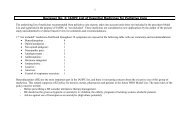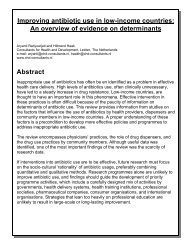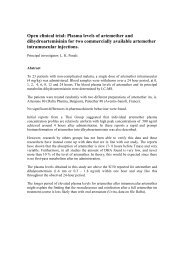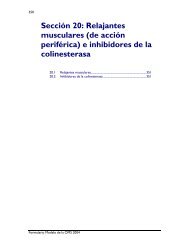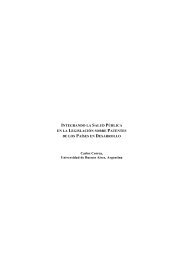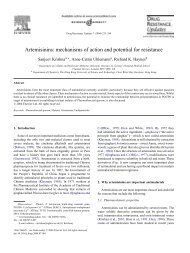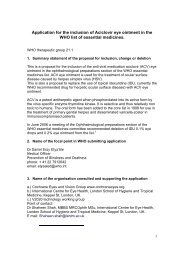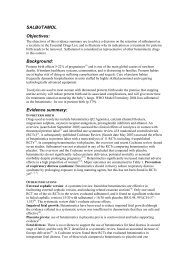Artesunate + mefloquine fixed-dose combination
Artesunate + mefloquine fixed-dose combination
Artesunate + mefloquine fixed-dose combination
You also want an ePaper? Increase the reach of your titles
YUMPU automatically turns print PDFs into web optimized ePapers that Google loves.
children below a body-weight of 30 kg and for adults of more than 55 kg. The overall experience out of<br />
these Artequin studies strengthened the decision to continue the clinical development plan of Artequin<br />
with the final goal to provide a <strong>fixed</strong>-<strong>dose</strong> <strong>combination</strong> of artesunate/<strong>mefloquine</strong> based on a pellet<br />
formulation for both active substances, and to further extend the <strong>dose</strong> range to small children not able<br />
to swallow tablets.<br />
Several pharmacokinetic and in-vitro investigations build the basis for a successful <strong>dose</strong>-linear<br />
downscaling of the high <strong>mefloquine</strong> <strong>dose</strong> formulation of Artequin Co-blister to the first real galenical<br />
formulation for small children, namely Artequin Paediatric Stickpack. Following findings and<br />
conclusions out of these investigations are of importance:<br />
Bioequivalence demonstrated between the <strong>mefloquine</strong> tablet formulation of Artequin and the<br />
reference product Lariam allows to conclude on similarity between the two formulations<br />
regarding efficacy and safety.<br />
Lack of clinically relevant pharmacological interaction between the two active ingredients<br />
artesunate and <strong>mefloquine</strong> allows to take for reference the huge clinical experience with the<br />
single substances in the <strong>dose</strong> designed for the FDC of Artequin Paediatric Stickpacks (daily<br />
<strong>dose</strong>s of artesunate 50 mg and <strong>mefloquine</strong> 125 mg). As a consequence, PK characteristics of<br />
both artesunate and <strong>mefloquine</strong> are supposed to be basically identical when administered<br />
alone or in <strong>combination</strong>. Therefore, the special clinical properties of the two antimalarials (fast<br />
but short acting artesunate – long lasting additive and protective effect of <strong>mefloquine</strong>) which<br />
are important for the ACT concept as used in the FDC Artequin Paediatric, are fully<br />
maintained in the <strong>combination</strong>.<br />
The proven linear <strong>dose</strong> dependency and proportionality of the pharmacokinetics of artesunate<br />
in the <strong>dose</strong> range of 50 to 200 mg and the known <strong>dose</strong>-linearity of <strong>mefloquine</strong> up to a <strong>dose</strong> of<br />
1000 mg is an important prerequisite for down-scaling the artesunate/<strong>mefloquine</strong> <strong>combination</strong><br />
from the already existing dosage forms of Artequin 600/1500 and 300/750 in <strong>dose</strong>-linear<br />
proportionality to Artequin Paediatric, i.e., to further halve the <strong>dose</strong> to the total therapeutic<br />
<strong>dose</strong> of 150 mg artesunate and 375 mg <strong>mefloquine</strong>.<br />
Similarity between the in-vitro dissolution profiles of the artesunate as well as <strong>mefloquine</strong><br />
pellets in Artequin Paediatric and of the artesunate and <strong>mefloquine</strong> tablets in Artequin Coblister<br />
demonstrate pharmaceutical equivalence of the two formulations. As a consequence,<br />
similar release of the active ingredients in the gastrointestinal tract, and thus, similar<br />
absorption patterns can be expected resulting in similar pharmacokinetic and<br />
pharmacodynamic characteristics of both the Artequin Co-blister dosage forms and the FDC<br />
of Artequin Paediatric.<br />
Study AM-P 001-2005, carried out on children with acute uncomplicated P. falciparum malaria in<br />
Gabon provides a formal prove that the galenical <strong>dose</strong>-linearity realised in the dosage of Artequin<br />
Paediatric results in similar PK characteristics in children with a body weight of 10 to 20 kg as reached<br />
with the double <strong>dose</strong>, i.e., with Artequin 300/750 given to children with body-weight >20 to 40 kg. As<br />
consequentially expected, the study outcome showed an appropriate efficacy of Artequin Paediatric<br />
Stickpacks and Artequin 300/750 co-blisters as measured by 28-day and 14-day cure rates of 100%<br />
with rapid parasite and fever clearance, in their respective target population. These high healing rates<br />
were in line with those demonstrated in the other clinical studies (all post-marketing phase IV as well<br />
as the randomized, comparative phase III studies). Irrespective of the <strong>dose</strong> administered with regard<br />
of the <strong>mefloquine</strong> partner drug of Artequin, there were never issues regarding the efficacy of the<br />
therapy over the whole <strong>dose</strong>-range investigated.<br />
Acceptability of intake of study medication is of great importance in pediatric patient populations as a<br />
prerequisite for compliance. Acceptability in the total paediatric study group kept constant above 80%<br />
over all three days of therapy which also demonstrate that no negative experience was linked to the<br />
drug administration, neither with tablets from Artequin 300/750 nor with the pellet formulation of<br />
Artequin Paediatric.<br />
11. Summary of comparative evidence on safety<br />
The safety of the <strong>Artesunate</strong> / <strong>mefloquine</strong> <strong>combination</strong> is fully presented in the registration file Artequin<br />
Paediatric which has been submitted to WHO pre-qualification team as well as to WHO GMP<br />
department.<br />
<strong>Artesunate</strong>/Mefloquine Hcl, Fixed <strong>dose</strong> <strong>combination</strong> 5/14



